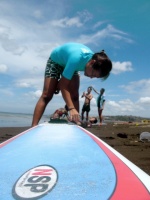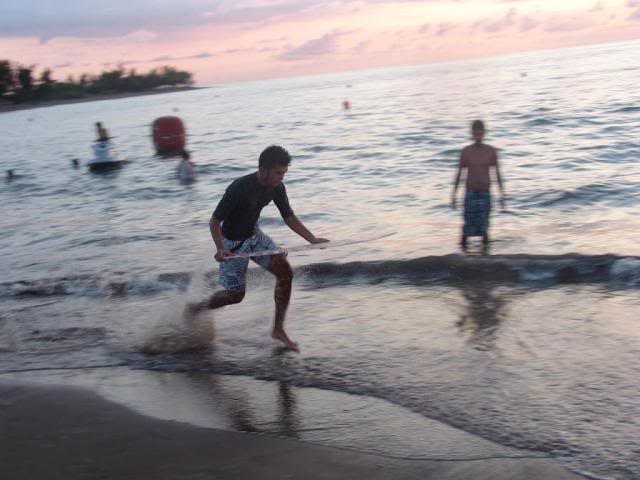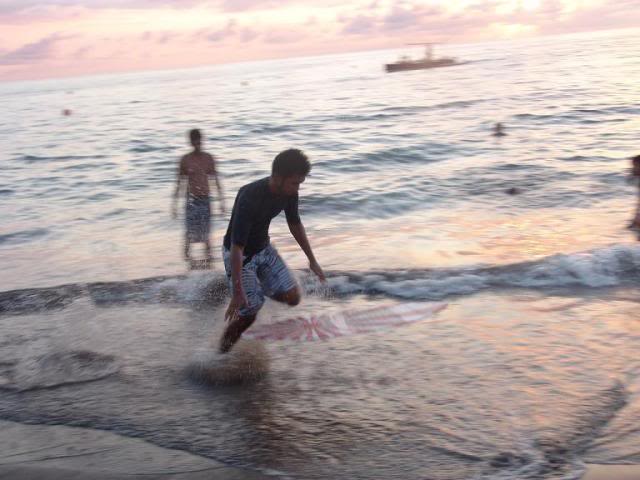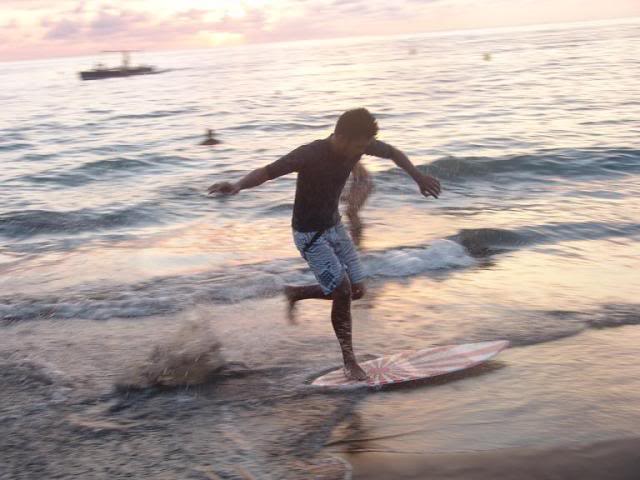How to Skimboard
+12
NixxiN
popsikel
nikki™
awtkas983
jepoykolokoy
herbman
mark
sub_zero
ayzayz
jaro man
woosa!
sk8punk
16 posters
ALON :: The Community :: Grom's Corner
Page 1 of 1
 How to Skimboard
How to Skimboard
How to Skimboard
Skimboarding on sand, and more importantly on waves, is one of the most fun, fastest growing, yet still small sports.
Steps
1. Find a good location. You don't have to live on a beach, but it would be easier so you could get more practice. Find a good beach, , preferably one with either very little slope (for sand skimming) or very powerful shore break and steep slope (for wave skimming).
2. Buy a board and surf wax*. You should buy different types of boards for sand skimming and wave skimming. Smaller, flatter, wooden boards (which are cheaper) are designed more so for sand skimming (sideways along the shore, where it's flat), whereas the newer high-tech foam/carbon fiber boards are shaped for reaching waves.
3. Find a good skim spot. This can be tough, but once you have a few places figured out, you'll always have somewhere to skim. San Diego, England, and Florida are some popular places.
4. Get in shape! You don't want to injure yourself doing this. Make sure you can run, ride on a board, take a few falls, and get a little sand on your face when you learn to skim. Keep your leg and back muscles stretched, warm, and strong.
5. Hold your board (preferably with one hand on the back tail and one hand on the side rail halfway up the board) out in front of you. If you're just going flat along the sand, wait until the last wave to come in is sucking back out. When there's a thin coating of water, between a couple millimeters and no more than a half inch, start running.
6. When you have some speed, drop your board flat out in front of you on this thin coating of water (almost like dropping it on the sand itself). The easiest way to do this is to get low to the ground and slide it out in front of you (to lead you just a little bit before you get on).
7. Get onto the board. Do not jump or hop onto the board. YOU WILL FALL and it will be boring. The only correct way to get on the board is to 'run' onto it, by placing your front foot a few inches past the middle first, then placing your back foot behind it. You may say, well I'll fall if I go one foot at a time. This is not the case. Properly done, you lose no speed as you get onto the board (Whereas if you jump onto it, the board is forced to break the surface tension of the water because of the sudden weight increase, taking away from the 'skim'). By gradually putting your weight onto the board, you will lose little or no speed. It's very smooth, and actually easier than jumping on once you're used to it.
8. Skim away. For sand skimming, it's simple...you just go, go, go...until you stop. You can stay straight, or you can try to do a shoot, or a big spin if you're lucky. Sand skimming is fun, but you can kick it up a notch by skimming waves.
9. Pick out a good wave. You'll need a wave that you can A) Reach, and B) Turn off of, or do an air off of. To help with speed as you go over deeper water, try side-slipping. This involves turning the board sideways as you go over flat sections of water (physics says it makes it lose speed at a slower rate). As you approach the wave, you'll need to start your turn by applying weight to your back inside/outside rail depending which way you're going. To lose less speed, try using the side rail more towards the middle of the board (instead of the back). This is much harder though, requires more practice and skill, and gives you less direct control of the wave. As you go up the face of the wave, you can turn off of it and come back down the other way towards shore. Eventually you may try aerials, grabs, and other tricks, too. Make sure to kick your tail out hard at the top of the wave as it starts to crest over to change directions and get a good spray going. This is all a very concise explanation of something very complicated and variable. Every beach, wave, sand texture, board, person, and condition is different. Experience is key in getting better.
Tips
* do not push off hard with your first foot when getting on the board. this will make the board go skew and fly away from you. when putting your second foot on do it as soon as your first foot is on.
* one exception to #7 is if you're water dropping when going for a wave. In this case, you're dropping the board on deeper water, which also requires an almost immediate step onto the board. If you do not get on the board asap, as in the very next step you take, a few bad things will happen. Firstly, the board could get away from you. This could be due to wind or the way you dropped it. Second, the board will start losing speed. Thirdly, you will end up running after your board in continually deeper water, thereby thwarting your running efforts, and making it harder to jump onto a board on a higher plane than you're running on. Having said all this, there certainly are advantages to water drops. First, you're getting closer to the wave--you're dropping and getting on the board closer to the wave, conserving speed and energy. If the wave is 30 yards away from where you start running, and you do a sand drop 20 yards away, you must skim 15 yards or so to get to the wave. If you do a water drop 15 yards away, you will need to skim that much less, resulting in reaching the wave with more speed and quicker. Water drops are more difficult, of course, but have extreme value when executed properly. (This only really applies to wave skimming).
* If you're skimming waves, buy a nice board from Exile, Victoria, Slotstik, Zap, or Sol. These are the 5 main brands of top of the line boards made of the best fiberglass/carbon fiber. Stay away from cheap alternatives such as Meyer and other brands. These might be good for beginners though. Those company's either use cheap materials, don't perform as well, or don't make wave riding boards, and are a waste of money. Buy some traction pads to attach to the top of your board as well to keep your feet in place as you start skimming more powerful waves.
* To perform a 360 or higher on a skimboard, you must get a lot of speed. When you get onto the board, bend over and stick your hand into the sand just long enough for the board to start spinning. Don't keep your hand in, otherwise you'll just slow you down. Shift your weight from your toes to your heels to avoid falling as your going backwards and forwards and such. If you do it right, you can do a 360! Or even more of a spin if your going even faster. If you seem to lose spin, but not any speed, stick your hand in again, or just bail.
* If you don't live near a beach you can also skimboard in shallow streams or rivers.
* You can apply a liberal coating of wax or a traction pad to lower your chances of slipping off the board.
* If you're first learning how to skimboard, it's a lot easier if you have someone else throw the board and run with you, while you grab their arm (for security) and start skimming.
Warnings
* Don't skim over your head so to speak. Stay in your comfort zone. If the waves look too big or powerful for you, then don't go for them. I.e, don't skim the wedge your first day.
* Without surf wax, you will fall off of your board repeatedly. Most skimboards are extremely slippery when wet, this is how they glide across water so well. Surf wax makes the board sticky so that you don't fall off. Cover the top surface with a fair amount of wax, and you can run comb through the wax to make it have more grip. You can also use traction pads instead of wax, though these are not recommended for beginners. A traction pad is a permanent rubber pad that you stick to the deck, which allows you to keep your footing without falling.
* practice sand drops and basic sandskimming over and over before you go near deeper water.
source
http://www.wikihow.com/
Skimboarding on sand, and more importantly on waves, is one of the most fun, fastest growing, yet still small sports.
Steps
1. Find a good location. You don't have to live on a beach, but it would be easier so you could get more practice. Find a good beach, , preferably one with either very little slope (for sand skimming) or very powerful shore break and steep slope (for wave skimming).
2. Buy a board and surf wax*. You should buy different types of boards for sand skimming and wave skimming. Smaller, flatter, wooden boards (which are cheaper) are designed more so for sand skimming (sideways along the shore, where it's flat), whereas the newer high-tech foam/carbon fiber boards are shaped for reaching waves.
3. Find a good skim spot. This can be tough, but once you have a few places figured out, you'll always have somewhere to skim. San Diego, England, and Florida are some popular places.
4. Get in shape! You don't want to injure yourself doing this. Make sure you can run, ride on a board, take a few falls, and get a little sand on your face when you learn to skim. Keep your leg and back muscles stretched, warm, and strong.
5. Hold your board (preferably with one hand on the back tail and one hand on the side rail halfway up the board) out in front of you. If you're just going flat along the sand, wait until the last wave to come in is sucking back out. When there's a thin coating of water, between a couple millimeters and no more than a half inch, start running.
6. When you have some speed, drop your board flat out in front of you on this thin coating of water (almost like dropping it on the sand itself). The easiest way to do this is to get low to the ground and slide it out in front of you (to lead you just a little bit before you get on).
7. Get onto the board. Do not jump or hop onto the board. YOU WILL FALL and it will be boring. The only correct way to get on the board is to 'run' onto it, by placing your front foot a few inches past the middle first, then placing your back foot behind it. You may say, well I'll fall if I go one foot at a time. This is not the case. Properly done, you lose no speed as you get onto the board (Whereas if you jump onto it, the board is forced to break the surface tension of the water because of the sudden weight increase, taking away from the 'skim'). By gradually putting your weight onto the board, you will lose little or no speed. It's very smooth, and actually easier than jumping on once you're used to it.
8. Skim away. For sand skimming, it's simple...you just go, go, go...until you stop. You can stay straight, or you can try to do a shoot, or a big spin if you're lucky. Sand skimming is fun, but you can kick it up a notch by skimming waves.
9. Pick out a good wave. You'll need a wave that you can A) Reach, and B) Turn off of, or do an air off of. To help with speed as you go over deeper water, try side-slipping. This involves turning the board sideways as you go over flat sections of water (physics says it makes it lose speed at a slower rate). As you approach the wave, you'll need to start your turn by applying weight to your back inside/outside rail depending which way you're going. To lose less speed, try using the side rail more towards the middle of the board (instead of the back). This is much harder though, requires more practice and skill, and gives you less direct control of the wave. As you go up the face of the wave, you can turn off of it and come back down the other way towards shore. Eventually you may try aerials, grabs, and other tricks, too. Make sure to kick your tail out hard at the top of the wave as it starts to crest over to change directions and get a good spray going. This is all a very concise explanation of something very complicated and variable. Every beach, wave, sand texture, board, person, and condition is different. Experience is key in getting better.
Tips
* do not push off hard with your first foot when getting on the board. this will make the board go skew and fly away from you. when putting your second foot on do it as soon as your first foot is on.
* one exception to #7 is if you're water dropping when going for a wave. In this case, you're dropping the board on deeper water, which also requires an almost immediate step onto the board. If you do not get on the board asap, as in the very next step you take, a few bad things will happen. Firstly, the board could get away from you. This could be due to wind or the way you dropped it. Second, the board will start losing speed. Thirdly, you will end up running after your board in continually deeper water, thereby thwarting your running efforts, and making it harder to jump onto a board on a higher plane than you're running on. Having said all this, there certainly are advantages to water drops. First, you're getting closer to the wave--you're dropping and getting on the board closer to the wave, conserving speed and energy. If the wave is 30 yards away from where you start running, and you do a sand drop 20 yards away, you must skim 15 yards or so to get to the wave. If you do a water drop 15 yards away, you will need to skim that much less, resulting in reaching the wave with more speed and quicker. Water drops are more difficult, of course, but have extreme value when executed properly. (This only really applies to wave skimming).
* If you're skimming waves, buy a nice board from Exile, Victoria, Slotstik, Zap, or Sol. These are the 5 main brands of top of the line boards made of the best fiberglass/carbon fiber. Stay away from cheap alternatives such as Meyer and other brands. These might be good for beginners though. Those company's either use cheap materials, don't perform as well, or don't make wave riding boards, and are a waste of money. Buy some traction pads to attach to the top of your board as well to keep your feet in place as you start skimming more powerful waves.
* To perform a 360 or higher on a skimboard, you must get a lot of speed. When you get onto the board, bend over and stick your hand into the sand just long enough for the board to start spinning. Don't keep your hand in, otherwise you'll just slow you down. Shift your weight from your toes to your heels to avoid falling as your going backwards and forwards and such. If you do it right, you can do a 360! Or even more of a spin if your going even faster. If you seem to lose spin, but not any speed, stick your hand in again, or just bail.
* If you don't live near a beach you can also skimboard in shallow streams or rivers.
* You can apply a liberal coating of wax or a traction pad to lower your chances of slipping off the board.
* If you're first learning how to skimboard, it's a lot easier if you have someone else throw the board and run with you, while you grab their arm (for security) and start skimming.
Warnings
* Don't skim over your head so to speak. Stay in your comfort zone. If the waves look too big or powerful for you, then don't go for them. I.e, don't skim the wedge your first day.
* Without surf wax, you will fall off of your board repeatedly. Most skimboards are extremely slippery when wet, this is how they glide across water so well. Surf wax makes the board sticky so that you don't fall off. Cover the top surface with a fair amount of wax, and you can run comb through the wax to make it have more grip. You can also use traction pads instead of wax, though these are not recommended for beginners. A traction pad is a permanent rubber pad that you stick to the deck, which allows you to keep your footing without falling.
* practice sand drops and basic sandskimming over and over before you go near deeper water.
source
http://www.wikihow.com/
Last edited by sk8punk on Mon Aug 11, 2008 8:41 pm; edited 1 time in total
 How to Skimboard on a Wave
How to Skimboard on a Wave
How to Skimboard on a Wave
When skimboarding on a wave, you feel the rush of surfing, but pay the price of buying a surfboard. It may be tough to master at first, but later you probably be doing pop shove its and aerial tricks. A skimboard is a smaller and rounder version of a surfboard. It is usually single tipped but can be double tipped for aerial tricks. Skimboarding is increasingly popular but is still a small sport.
Steps
1. Make sure you have a "foamie" and not a "woody". Foamie's are designed for riding waves, lighter, but cost more. Woodie's are wooden fiberglass boards which are prodominantly made for sand skimming, but if you cannot get a foamie, they will suffice.
2. Know that when you have your board, find a beach that you can is best for skimboarding. You want a beach where the waves break close to shore and has a steep bank down near the water.
3. Wait until you have found a good beach, then get out your board and approach the water. Stand about ten feet away from the water and be prepared to throw down your board.
4. Undertand that right after a wave breaks, start running towards the water. Do not flat out sprint because you will fall off when you get on the board if you are a beginner.
5. Look to see when a thin film of water is on the sand, throw down the board. Don't throw it away from you, throw it down so you will run on to it in stride. Run onto it with your front leg first, then your back foot. Keep all of your weight on your back leg so you glide into the water, instead of plowing through it.
6. Know that if you have run onto your board successfully, you will be approaching a developing wave. If it has not started to break yet you have three options. Option one is to hit the wave straight on a perform and aerial trick. Option two is to perform a wrap or a barrel wrap. Option three is to turn to the left or right (depending on which way the wave is breaking) and come back to shore.
7. Have fun!
Tips
* Try to skim away from rocks and people
* Wax your board with surfers wax by criss-crossing it across the board
* Kick sand at the bottom of your board for stablization
* Don't skim in the dark or when a lifeguard is not on duty
* Pricing for good foamies go from 120-170 dollars
* Pricing for good woodies go from 40-80 dollars
Warnings
* It is possible to paralyze yourself or die while skimboarding
* Performing aerial tricks is very dangerous and your board can land on you
* You may lose your board if you do not find it at the most one minute after a fall
Things You'll Need
* Foamie (Woody is okay)
* Surfboard wax
* A beach with sand
* Water
* Close breaking waves
* Balance
source
http://www.wikihow.com/
When skimboarding on a wave, you feel the rush of surfing, but pay the price of buying a surfboard. It may be tough to master at first, but later you probably be doing pop shove its and aerial tricks. A skimboard is a smaller and rounder version of a surfboard. It is usually single tipped but can be double tipped for aerial tricks. Skimboarding is increasingly popular but is still a small sport.
Steps
1. Make sure you have a "foamie" and not a "woody". Foamie's are designed for riding waves, lighter, but cost more. Woodie's are wooden fiberglass boards which are prodominantly made for sand skimming, but if you cannot get a foamie, they will suffice.
2. Know that when you have your board, find a beach that you can is best for skimboarding. You want a beach where the waves break close to shore and has a steep bank down near the water.
3. Wait until you have found a good beach, then get out your board and approach the water. Stand about ten feet away from the water and be prepared to throw down your board.
4. Undertand that right after a wave breaks, start running towards the water. Do not flat out sprint because you will fall off when you get on the board if you are a beginner.
5. Look to see when a thin film of water is on the sand, throw down the board. Don't throw it away from you, throw it down so you will run on to it in stride. Run onto it with your front leg first, then your back foot. Keep all of your weight on your back leg so you glide into the water, instead of plowing through it.
6. Know that if you have run onto your board successfully, you will be approaching a developing wave. If it has not started to break yet you have three options. Option one is to hit the wave straight on a perform and aerial trick. Option two is to perform a wrap or a barrel wrap. Option three is to turn to the left or right (depending on which way the wave is breaking) and come back to shore.
7. Have fun!
Tips
* Try to skim away from rocks and people
* Wax your board with surfers wax by criss-crossing it across the board
* Kick sand at the bottom of your board for stablization
* Don't skim in the dark or when a lifeguard is not on duty
* Pricing for good foamies go from 120-170 dollars
* Pricing for good woodies go from 40-80 dollars
Warnings
* It is possible to paralyze yourself or die while skimboarding
* Performing aerial tricks is very dangerous and your board can land on you
* You may lose your board if you do not find it at the most one minute after a fall
Things You'll Need
* Foamie (Woody is okay)
* Surfboard wax
* A beach with sand
* Water
* Close breaking waves
* Balance
source
http://www.wikihow.com/
 Re: How to Skimboard
Re: How to Skimboard
run drop smile?  bakit my smile? hehehe....
bakit my smile? hehehe....
 bakit my smile? hehehe....
bakit my smile? hehehe....
jaro man- Skimboarder

- Posts : 470
Join date : 2008-07-27
Age : 39
Location : zambales
 Re: How to Skimboard
Re: How to Skimboard
1. Make sure you have a "foamie" and not a "woody". Foamie's are designed for riding waves, lighter, but cost more. Woodie's are wooden fiberglass boards which are prodominantly made for sand skimming, but if you cannot get a foamie, they will suffice.
hehe sna lang nde mahirap mag switch from woody to foamie wave riding kc tlaga trip ko
wave riding kc tlaga trip ko
hehe sna lang nde mahirap mag switch from woody to foamie
 wave riding kc tlaga trip ko
wave riding kc tlaga trip ko Re: How to Skimboard
Re: How to Skimboard
hehehehe, wala lang tol, pacute lang! hahahahaha! saya kase magskim eh!jaro wrote:run drop smile?bakit my smile? hehehe....
 Re: How to Skimboard
Re: How to Skimboard
it requires no normal training, and it can be enjoyed virtually anywhere that wave breaks...

jaro man- Skimboarder

- Posts : 470
Join date : 2008-07-27
Age : 39
Location : zambales
 Re: How to Skimboard
Re: How to Skimboard
yeah!! make it sure ready kau kasugatan.. tpos kung nkaride kna,smile!!! den apir!!! 


sub_zero- Skimboarder

- Posts : 320
Join date : 2008-07-12
Age : 39
Location : manila
 Re: How to Skimboard
Re: How to Skimboard
hehe problema ko d ako masyado makabasa ng wave, nalilito pa ko. tips anyone?? 


mark- Beachcomber

- Posts : 95
Join date : 2008-07-29
Age : 44
Location : laid back las piNas city
 Re: How to Skimboard
Re: How to Skimboard
watch, run, drop, slide, catch, ride, feel....

herbman- Posts : 4
Join date : 2009-01-07
 Re: How to Skimboard
Re: How to Skimboard
run, drop, roll and burn....

jepoykolokoy- Skimboarder

- Posts : 270
Join date : 2008-10-22
 Re: How to Skimboard
Re: How to Skimboard
jepoykolokoy wrote:run, drop, roll and burn....
hahahhahaa....nice idea!

herbman- Posts : 4
Join date : 2009-01-07
 Re: How to Skimboard
Re: How to Skimboard
herbman wrote:jepoykolokoy wrote:run, drop, roll and burn....
hahahhahaa....nice idea!
pwede din RUN DROP and SMILE (OTEP move)

awtkas983- Hardcore Skimboarder

- Posts : 783
Join date : 2008-07-04
 Re: How to Skimboard
Re: How to Skimboard
ang bangis...hahahahha...

nikki™- Hardcore Skimboarder

- Posts : 594
Join date : 2008-08-05
Location : T o N D O * G i R L
 Re: How to Skimboard
Re: How to Skimboard
ako nanood muna sa marurunong magskim nun 1st tym ko hehehe ..
kaya watch, run drop, roll sa sand (normal lang naman un), tas balance pagka ride mo sabi nila mgotso-otso raw tuwad onti pra mas madali mgbalance pag ok kng mgbalance kahit ano na go go go na skim lang ng skim
sabi nila mgotso-otso raw tuwad onti pra mas madali mgbalance pag ok kng mgbalance kahit ano na go go go na skim lang ng skim 
kaya watch, run drop, roll sa sand (normal lang naman un), tas balance pagka ride mo

popsikel- Beach Bum

- Posts : 186
Join date : 2008-11-06
Age : 41
Location : cavite
 Re: How to Skimboard
Re: How to Skimboard
skim lang ng skim pag may budget! 

mark- Beachcomber

- Posts : 95
Join date : 2008-07-29
Age : 44
Location : laid back las piNas city
 Re: How to Skimboard
Re: How to Skimboard
2ruan nyo ko mag skim para makapag advice din ako d2.. hahahaha.. ^^

NixxiN- Beachcomber

- Posts : 71
Join date : 2009-03-25
Location : Antipolo City
 Re: How to Skimboard
Re: How to Skimboard
anu yung direction pag tatakbo ka? run perpendicular to the direction of the waves? or 45 degrees?
c_noob- Posts : 2
Join date : 2009-06-06
 Re: How to Skimboard
Re: How to Skimboard
c_noob wrote:anu yung direction pag tatakbo ka? run perpendicular to the direction of the waves? or 45 degrees?
kahit saan. kung ano ung kailangan mong makuha. since tinanong mo to, sa tingin ko dapat parallel lang muna sa shore ung pagtakbo mo. madaling magskim sa manipis na tubig. habang lumalalim ung tubig ng pinagbababaan at pinagsasakyan mo ng board mas nagiging mahirap na.
 Similar topics
Similar topics» How to Identify Skimboard Types
» Skimboard
» choosing a right skimboard
» im making a board right now...
» i want a skimboard
» Skimboard
» choosing a right skimboard
» im making a board right now...
» i want a skimboard
ALON :: The Community :: Grom's Corner
Page 1 of 1
Permissions in this forum:
You cannot reply to topics in this forum








